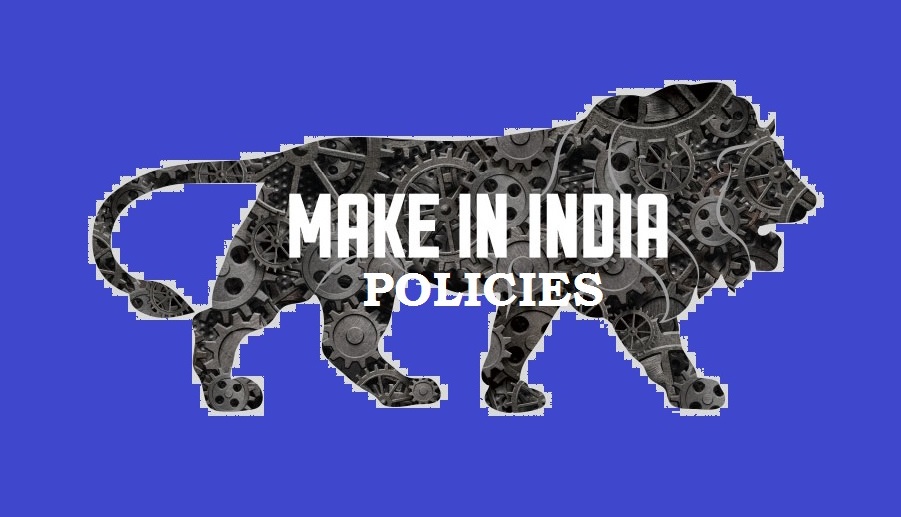Prime Minister of India Narender Damodardas Modi launched various new projects and campaigns to improve the economy of India. One such project is Make In India. Make is India is actually a bunch of policies mainly drafted to promote manufacturing of different products within the country.
If you are planning to start a business in India by investing in Make in India project then this is the best time to invest. Indian government has changed many policies and rules for the companies under Make in India. Now, if you are confused or don’t know much about the Make in India Policy, then read on. This post is to remove all the uncertainties that would have been erupting in your mind regarding policies of Make In India.
Let’s discuss Make in India Policies now. There are 4 Policies of Make in India, namely
- National Manufacturing Policy
- National Intellectual Property Rights (IPR) Policy
- Foreign Direct Investment Policy
- New Initiatives
Related- Advantages and Disadvantages of Make in India
1. National Manufacturing Policy
This policy focuses on all those areas that are related to the regulation, skill development, infrastructure, technology, exit mechanism, availability of finance, and other factors that are helpful in the growth of manufacturing sector of the country.
Motive of National Manufacturing Policy
The prime motive of this policy is to encourage the development of the business sector, create employment opportunities, and bring more and more investment in the manufacturing sector. Other motives are-
- 12-14% increase in the growth of manufacturing sector.
- By 2022, the share of manufacturing sector in the Gross Domestic Product to be increased from 16% to 25%.
- To create 100 million jobs in the manufacturing sector by 2022.
- Establishing National Investment and Manufacturing Zones (NIMZ) that will be equipped with superior infrastructure, self-regulated, and will be in partnership with the private sectors.
- To create the perfect opportunities for the poor and urban migrant to learn the skills used in the manufacturing sector.
- Increasing domestic value addition and technology in this sector.
- Enhancing the competitive power of Indian manufacturing sector in the global market.
- Ensuring proper growth in the sector.
- Organisation of industrial training and skill development programs.
- More focus on the sectors that generate employment, strategic development, capital goods, and competitive sector.
Related- Advantages and Disadvantages of GST
Conclusion of National Manufacturing Policy
- Small & Medium enterprises can get the refund on technology purchase.
- Workable laws of labor.
- Simple exit mechanism for sick units.
- Tax incentives to small & medium enterprises.
- Incentive for green manufacturing.
- Exemption from rules & regulations related to the environment, labor, etc.
- Web-enabled process of clearance by center & state authorities.
- In case the reinvestment is considered for the purchase of plant and machinery within the period of 3 years, then there will be relief on the capital gains tax.
- For the production of equipment/devices/machines that help in controlling the pollution, reduce water and energy conservation, 5% interest will be refunded and 10% capital subsidy will be granted.
- For units practicing zero water discharge, 10% of one-time capital subsidy will be granted.
Related- What is GST
2. National Intellectual Property Rights (IPR) Policy
This policy is the first ever single policy that covers every sort of intellectual property in one framework. This policy focuses on creating, facilitating, promoting, and commercializing Intellectual Property assets in India.
Motive of IPR Policy
- Creating awareness among every section of the society regarding the economic, cultural, and social benefits of IPRs.
- Stimulating the generation of IPRs.
- Creating strong and efficient IPRs laws.
- Strengthening and modernizing IPRs administration.
- Strengthening institutions and capacities for teaching, research, skill-building, and training; as well as expanding human resources.
- Enhancing access to environmental protection, food security, and healthcare.
Conclusion of IPR Policy
- The policy does not focus on the condition of patent filing in the country and there are no measures to improve it.
- The policy has recommended some changes to the current mechanism so as to broaden the concept of IPRs.
- More power to the IPO (Initial Public Offerings) and coordination between different IPOs.
3. Foreign Direct Investment Policy
The Foreign direct investment policy is nothing new, but there have been some changes made by the current government of the country. This policy is the supreme source of foreign investment that helps the economy of India a lot.
Changes Made due to Foreign Direct Investment Policy
- The FDI inflow was increased from 26% to 49% in the sector of insurance.
- The norms of policy for 25 sectors were made easier.
- FDI for the defense sector will be used in producing small arms and ammunitions for the army.
- Changes in the entry of new companies were made and now it is easier for people to start their ventures.
- Changes in the tax policies were made.
Conclusion of Foreign Direct Investment Policy
- The rank of India in terms of FDI was increased from 15th to 9th position in 2014.
- Mauritius, Japan, Singapore, Netherlands, and USA invested most of the amount in India.
- The FDI in the automotive sector of India was increased by 89% in 2014-15.
4. New Initiatives Policy
The new initiatives by the government of India are designed to facilitate investment, protect intellectual property, foster innovation.
New Infrastructure in New Initiative Policy
- Smart City Mission for 19 cities
- Delhi-Mumbai Industrial corridor
- 14 national investment and manufacturing zone.
- Industrial projects.
New sectors in New Initiative Policy
- Defense-
- 49% automatic route, FDI above 49% through government route.
- Civil Aviation-
- In Greenfield projects, 100% FDI under automatic route.
- In Brownfield projects, 74% FDI under the automatic route.
- In Brownfield projects, FDI is beyond 74% under government route.
Although through Make In India, the government has targeted to develop the economy of the country and the concept is highly innovative and beneficial for the country. But, considering the some of the policies and schemes that couldn’t reach their destination, it can be a tough job for the ministers and the public to stick to the actions initiated by the government.
Some strict rules, discipline, and adherence to the policies can create a huge difference in the current situation of the country. All in all, everything depends on the steps that the government takes to turn this concept into reality and the coordination that the public shows to take India some steps ahead.






Hi Everyone,
Make in India is a good platform of the country to make it smart, Digital and producer of the goods in the globe. Other countries have started to invest money in India after Make in India project.
It is a very good platform for small and medium scale industries to start an industry.